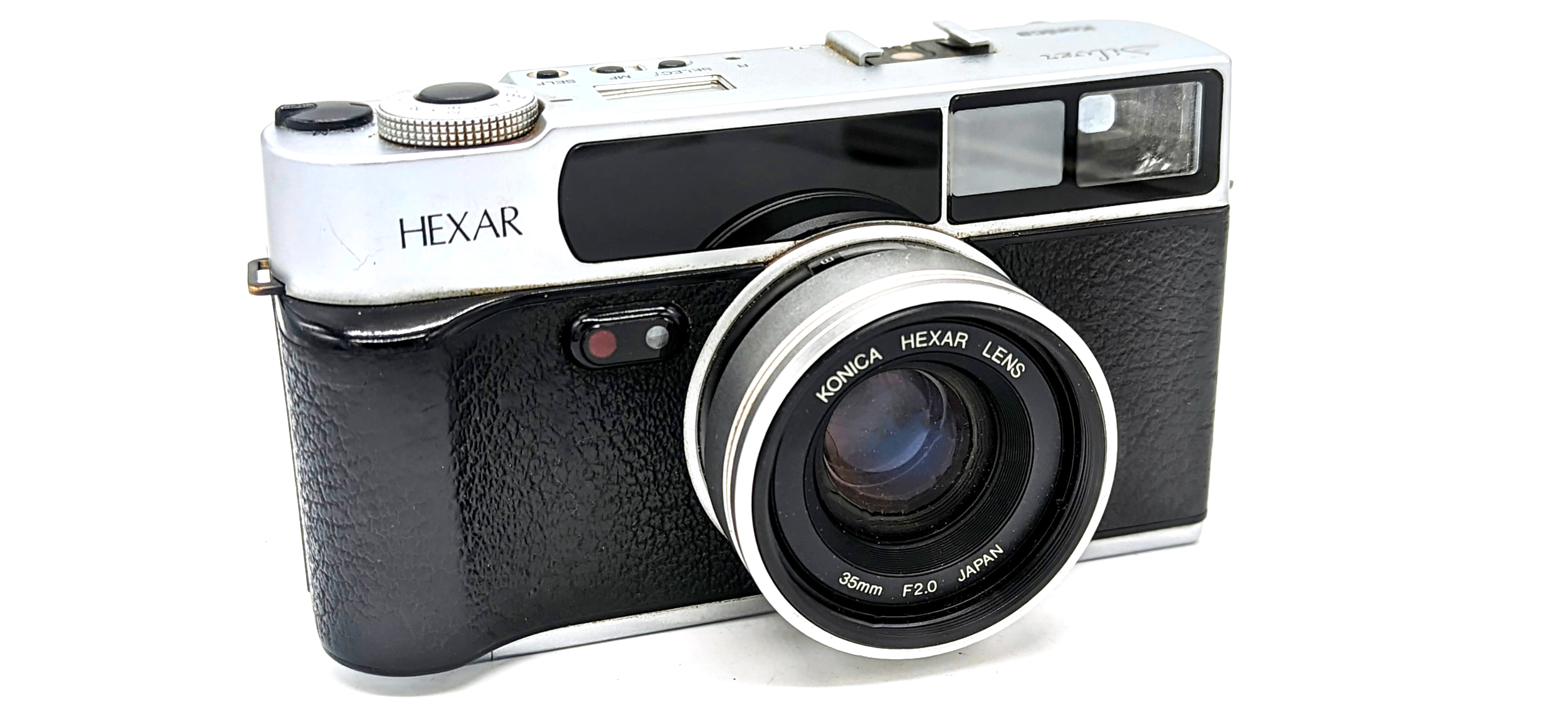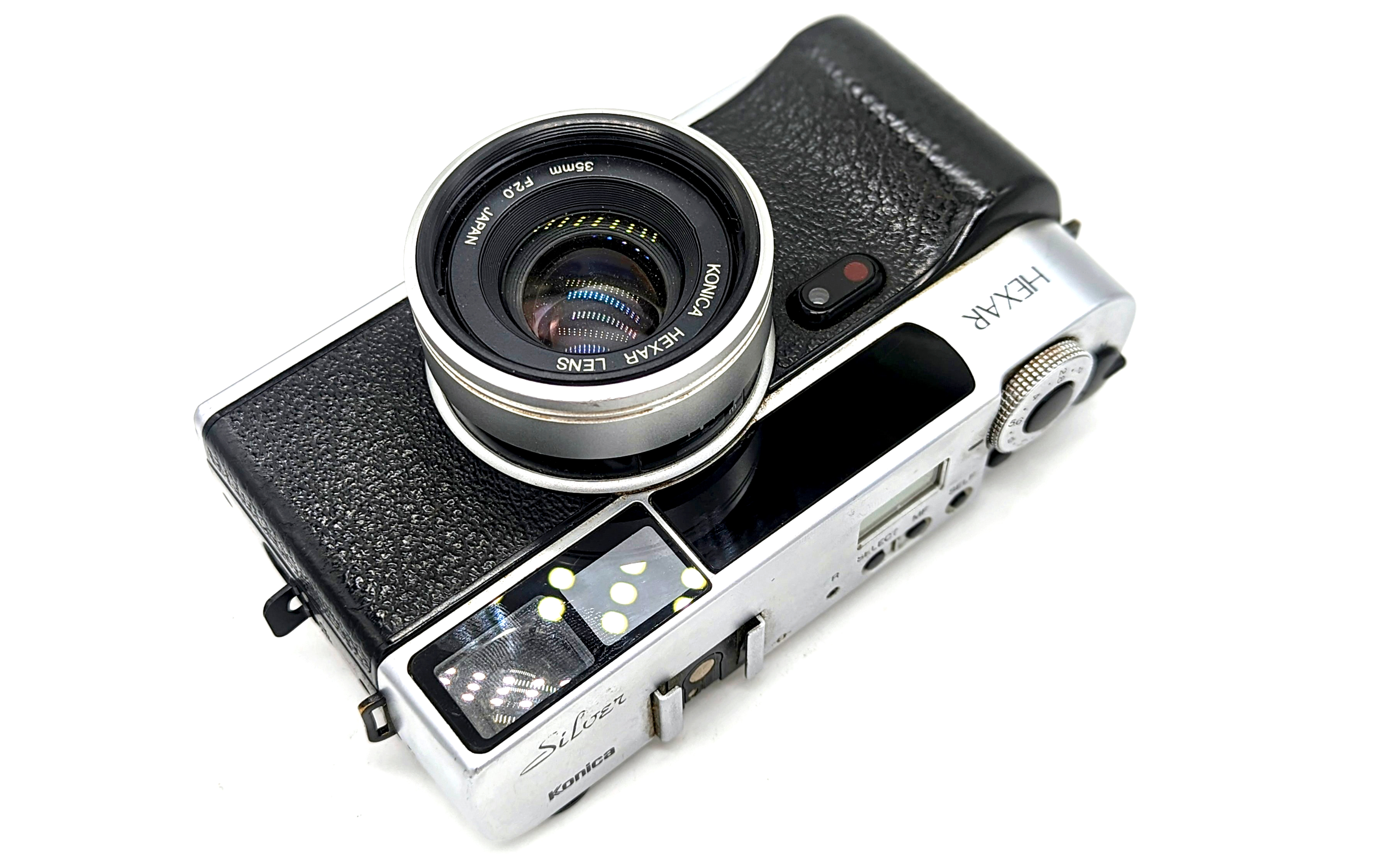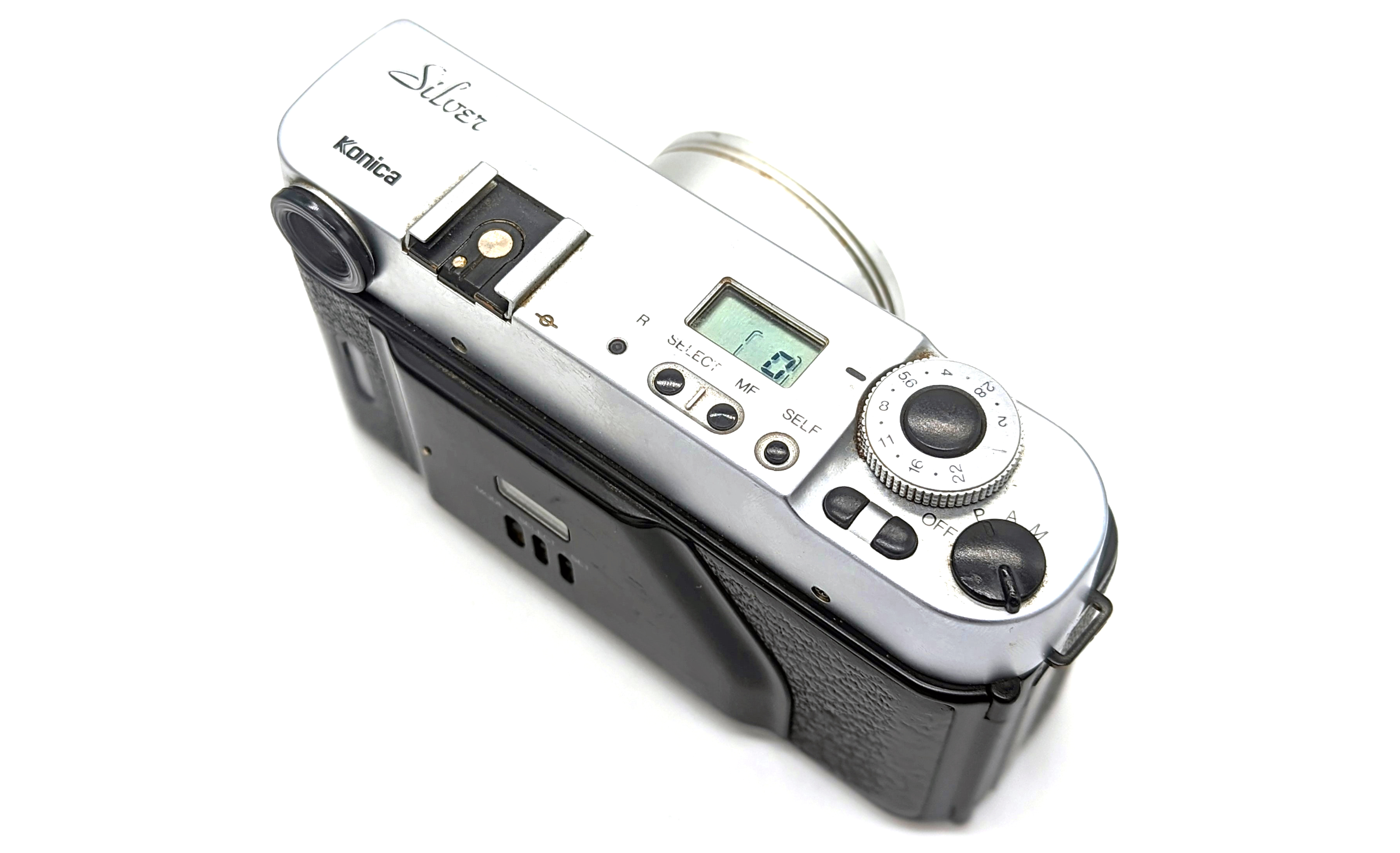
Without a doubt, the 1993 Konica Hexar AF was and remains the most advanced fixed-lens 35mm “point and shoot” ever produced. Konica centered this masterpiece around its newly-designed 35mm f/2 Hexar, a direct descendant of the famous 1950s Nikon 35mm f/1.8 W-Nikkor, which itself was produced in relatively small quantities in Nikon rangefinder and Leica screw mount.
Nothing about Konica’s early 1990s camera product line, consisting mostly of semi-advanced point-and-shoots in the form of the “Big Mini” series, would have foreshadowed the AF. The AF’s most immediate ancestor appears to have been the 1988 Konica “Genba Kantoku” series of autofocus point-and-shoots made for the construction industry. That line had four basic models, with the following lenses: a 28mm f/3.5, a 35mm f/3.5, a switchable 40mm / 60mm, and a 28-56mm zoom. These tough, weatherproof cameras were entirely automated with no meaningful user override. These cameras were never really exported to North America and remained largely unknown outside of Japan until the internet era.
The Hexar AF came in two primary versions: the black original Hexar AF (1993) and the better-featured Hexar AF Silver (1997). There were also a few limited editions like the “Classic,” the “Gold,” and the “Rhodium.” With the AF Silver arguably being the “definitive” version, let’s take a look at that one specifically.
Specifications Compared
Here is the AF compared with the internet’s favorite point-and-shoots with fixed lenses around the 35mm focal length: the Contax T3, the Fujifilm Klasse, the Leica Minilux, the Nikon 35Ti, and the Yashica T4.
| Hexar AF Silver | Contax T3 | Fujifilm Klasse S | Leica Minilux | Nikon 35Ti | Yashica T4 | |
| Year Introduced | 1997 | 2001 | 2007 | 1995 | 1993 | 1990 |
| ASA Range | 6-6400 | 25-5000 | 25-3200 | 25-5000 | 25-5000 | 50-3200 |
| ASA Override? | Yes | No; Non-DX Defaults to ASA 100 | Yes | No; Non-Dx Defaults to ASA 100 | No; Non-Dx Defaults to ASA 100 | No; Non-Dx Defaults to ASA 100 |
| Lens | 35mm f/2 | 35mm f/2.8 | 38mm f/2.8 | 40mm f/2.4 | 35mm f/2.8 | 35mm f/3.5 |
| Lens Design | 7 Elements / 6 Groups | 6 Elements / 4 Groups | 4 Elements / 3 Groups | 6 Elements / 4 Groups | 6 Elements / 4 Groups | 4 Elements / 3 Groups |
| Lens Type | Modified Xenotar | Sonnar | Tessar | Double-Gauss | Double-Gauss | Tessar |
| Viewfinder Coverage / Mag. | ? | 85% / .50x | 85% / .48x | 83% / .35x | 85% / .50x | ? |
| Filter Size | 46mm | None; Accessory for 30.5mm Filters | None | None | None | None |
| Metering | Center / Spot (in M) | Center | Center | Center / Spot | Center | Center |
| Min. Focus | 0.60m | 0.35m | 0.40m | 0.70m | 0.40m | 0.35mm |
| Focus Lock? | Yes | Yes | Yes | Yes | Yes | Yes |
| Auto Parallax-Corrected? | Yes; Automatic | No | No | No | No | No |
| Exposure Modes | P / A / M | P / A | P / A | P / A | P / A | P |
| Exposure Compensation? | +/- 2 | +/- 2 | +/- 2 | +/- 2 | +/- 2 | None |
| Max Shutter Speed | 1/250 | 1/1200 | 1/500 (f/2.8); 1/1000 (f/16) | 1/400 | 1/500 | 1/700 |
| Flash | External GN System | Built-In; Optional External TLA 200 | Built-In | Built-In | Built-In | Built-In |
| Battery | 2CR5 | CR2 | CR2 | CR123A | CR123A | CR123A |
| Weight | 495g | 230g | 270g | 366g | 310g | 190g |

The Good
I have owned a Hexar AF Silver for over 20 years. In my opinion, the most impressive aspects of the AF include: (1) its fantastic lens; (2) its modern implementation of the 1960s guide number flash system; (3) its nice parallax-corrected viewfinder; (4) extensive user control over all of its functions; (5) its optional “silent mode;” and (6) the ability to use regular camera filters.
Lens: The 35mm f/2 Hexar lens on the AF is a multicoated, Xenotar-type descendant of the Nikon’s 35mm f/1.8 W-Nikkor. The two lenses perform remarkably similarly. The Hexar even displays the same focus shift as the Nikkor. Aware of the focus shift issue, Konica designed the autofocus system of the AF to compensate automatically for any shift in focus. The Hexar’s only real shortcoming is its noticeable barrel distortion. Oddly enough, the 1950s W-Nikkor’s barrel distortion is much better controlled, perhaps due to its use of discontinued (and slightly radioactive) lanthanum glass. The Hexar AF’s lens was so desired that large Japanese camera stores commissioned Konica to produce several Leica screw mount versions of it, including the limited edition, brass-barrel 35mm f/2 UC Hexanon.
Guide Number Flash System: The AF’s electronic leaf shutter permits flash synchronization at all shutter speeds. The AF’s external hot shoe flash system was a modern implementation of the old 1960s guide number flash system, appearing in such products as the Auto SE and the Auto S3. This system was quite ingenious. Using virtually any electronic flash in existence that has a manual mode, the user would simply dial in the flash’s guide number (at ASA 100). With the camera knowing that the flash would always fire at that full power setting, it would automatically compensate for both the ambient lighting and the focusing distance to arrive at the correct exposure for both indoor and daylight conditions. Of course, the AF can also use any regular old electronic “auto mode” flash. Konica did offer the HX-14 flash that could operate both in GN and auto mode.
Automatically Parallax-Corrected Viewfinder: The AF’s bright viewfinder automatically compensates for parallax error by collapsing the framelines to the appropriate size. The viewfinder also includes lights for over/under exposure, a spartan distance scale which collapses appropriately, and a warning light if the subject is too close to focus.
Silent Mode: During the 1990s, Konica got into a bit of legal trouble by including an optional “silent mode” where the camera makes virtually no noise when autofocusing, tripping the shutter, and advancing the film. This apparently appropriated another company’s intellectual property. While this function does slow down the autofocus, it is still doable. The focus and advance are not truly “silent,” but they are pretty muted. Because of the aforementioned legal trouble, Konica stated that it had “removed” this feature from the AF Silver. However, if you know the secret code, you can enable it.
Filters: The AF’s compatibility with any screw-in 46mm filters is another great attribute. Filters are very useful for, e.g., protecting a lens, for black and white photography, and for increasing exposure time with neutral density filters.

Functionality
Without going through the whole list, here are the salient features of AF in no particular order:
Multiple Exposure Modes: The AF can operate in three separate modes: Program, Aperture-Priority, and Manual. “Program” is a true point-and-shoot mode, with the camera setting both the aperture and shutter speed. “Aperture Priority” is also straightforward, with you setting the aperture on the rotating dial and the camera sets the appropriate shutter speed. Manual mode is less straightforward, with you setting the aperture on the dial and then scrolling through some buttons to set the shutter speed via the LCD.
Minimum Shutter Speed Setting: To prevent camera shake from ruining your photos, you can program the AF to a minimum shutter speed while in Program or in Aperture-Priority mode: 1/4 to 1/60 of a second. I find that 1/30 is generally sufficient if you have a somewhat steady hand.
Focus & Exposure Lock: A half press of the shutter button will lock both the focus and exposure. This is an essential feature for this type of camera.
Exposure Compensation: In either P or A mode, you can easily set exposure compensation using two buttons beneath the switch.
Film Speed Override: The DX override is a fantastic feature. It allows one to use non-DX coded film cassettes at any ASA. It also works well for exposure compensation when using filters.
Automatic Infrared Film Focus Compensation: When using infrared film, the AF has a setting that will automatically adjust the focus appropriately.
Multiple Exposures: The AF has a feature that easily permits multiple exposures, as many of you want, within reason.
The So-So
Despite the AF’s impressive optics and features, there are a few aspects that could have been better.
1/250 Top Shutter Speed: The most popular gripe about the AF is its relatively-low maximum shutter speed of 1/250. This limitation is puzzling as leaf shutters can often achieve at least 1/500.
Size/Dimensions: Although the AF generally operates like a point-and-shoot, it is not point-and-shoot sized, more resembling the dimensions of a classic 1960s fixed-lens rangefinder.
No Exposure Information in Viewfinder: While the AF’s viewfinder contains automatic parallax corrected framelines, an abbreviated distance scale, warnings for over/under exposure, and an indication if the subject is too close to focus, there is no actual exposure information communicated.
Too Many Buttons? While the AF can do a lot, many of its advanced functions require some button and switch combinations that are neither necessarily intuitive or easy to remember without a cheat sheet.
The Data Back: The AF Silver came with a data back whose only function is to perhaps ruin your photo by imprinting a date on the bottom right quadrant of your negative. While this function may have been useful for some documentary, industrial, or scientific purposes, it is useless for taking real photos. The date function only goes up to December 31, 2019.
Tips for Use
Neutral Density Filters: One of the best things you can do to get the most out of the AF is to invest in a high-quality 2 or 3 stop neutral density filter. If using 400/800 speed film in daylight conditions, a neutral density filter is pretty much necessary. A 3-stop ND filter reduce 400 speed film to 50 and 800 speed to 100, allowing you to use the same roll in a variety of lighting conditions.
Unlock the Silent Mode!: If you have a Silver AF, that had the silent mode disabled from the factory, be sure to unlock the secret silent mode. The code can be found through an internet search.
Take Advantage of the GN Flash System: Because the AF Silver does not require the use of a proprietary flash, invest in whatever large or small flash that suits you, as long as it can shoot in manual mode (i.e., full, 1/2, 1/4 power, etc.). The Konica HX-14 flash is cute but not necessary. The daylight fill flash feature works quite well but can lean towards a little overexposure, just like SLR TTL flashes.
Treat It Like a Point and Shoot: At the end of the day, although the AF has remarkable capability and user override, in my opinion, the AF is really best used as an advanced point and shoot that can excel in available-light situations.
I still regret selling mine during my Leica M2 honeymoon period; but I’ve ran into issues with shutter switch reliability on multiple occasions and couldn’t really trust it fully after that. Not that I didn’t try to pack a JIS screwdriver whenever I went 🙂
I liked the predictability of the “P” mode – it’s essentially “A” mode, just with training wheels. It’ll use the selected aperture, as long as the shutter doesn’t hit a limit (either 1/250, or the lowest configured speed). “A” mode will cheerfully let you shoot yourself in the foot if you’re not careful.
Oh, by the way, since you have the date back – I’ve always wondered: what’s the highest date that you can set on it?
According to the manual, to December 31, 2019.